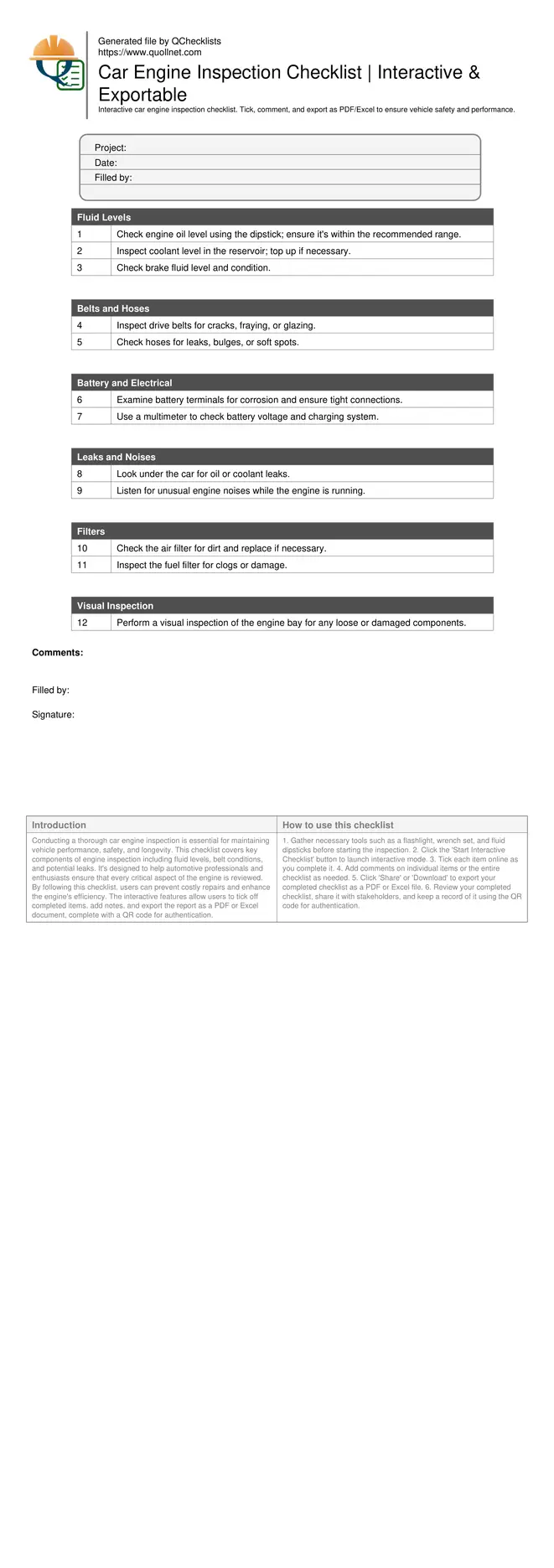Comprehensive Car Engine Inspection
Conducting a thorough car engine inspection is essential for maintaining vehicle performance, safety, and longevity. This checklist covers key components of engine inspection including fluid levels, belt conditions, and potential leaks. It's designed to help automotive professionals and enthusiasts ensure that every critical aspect of the engine is reviewed. By following this checklist, users can prevent costly repairs and enhance the engine's efficiency. The interactive features allow users to tick off completed items, add notes, and export the report as a PDF or Excel document, complete with a QR code for authentication.
- Comprehensive inspection covering fluid levels, belts, and leaks to ensure optimal engine performance.
- Prevents costly repairs by identifying potential issues early.
- Enhances vehicle safety and longevity through detailed checks.
- Interactive online checklist with tick, comment, and export features secured by QR code.
Fluid Levels
Belts and Hoses
Battery and Electrical
Leaks and Noises
Filters
Visual Inspection
Why Regular Engine Inspections Matter
Regular engine inspections are crucial for detecting potential issues before they become major problems. An inspection can reveal wear and tear, fluid leaks, and other anomalies that might affect the engine's performance. By routinely checking the engine, car owners can ensure that their vehicles run efficiently and safely.
- Detects early signs of wear and tear.
- Prevents unexpected breakdowns.
- Optimizes vehicle performance and fuel efficiency.
- Ensures compliance with safety standards.
Key Components of Engine Inspection
An effective engine inspection involves checking several components, including fluid levels, belts, hoses, and the condition of the battery. Each component plays a vital role in the vehicle's overall functionality. Identifying any issues early can significantly reduce repair costs and increase the engine's lifespan.
- Check engine oil and coolant levels.
- Inspect belts and hoses for signs of wear.
- Examine the battery and its connections.
- Look for any visible leaks or unusual noises.
How to Use This Car Engine Inspection Checklist
- Gather necessary tools such as a flashlight, wrench set, and fluid dipsticks before starting the inspection.
- Click the 'Start Interactive Checklist' button to launch interactive mode.
- Tick each item online as you complete it.
- Add comments on individual items or the entire checklist as needed.
- Click 'Share' or 'Download' to export your completed checklist as a PDF or Excel file.
- Review your completed checklist, share it with stakeholders, and keep a record of it using the QR code for authentication.
Call to Action
-
Start Interactive Checklist
Tick off tasks, leave comments on items or the whole form, and export your completed report to PDF or Excel—with a built-in QR code for authenticity.
- Download Excel - Car Engine Inspection
- Download PDF - Car Engine Inspection
- View Image - Car Engine Inspection
